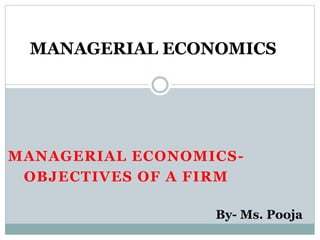
Managerial Economics- objective of firm
- 1. MANAGERIAL ECONOMICS- OBJECTIVES OF A FIRM MANAGERIAL ECONOMICS By- Ms. Pooja
- 2. Firm and its Objective
- 6. Baumol’s Sales Maximization SALES MAXIMISATION According to Baumol, with the separation of ownership and control in modern corporations, managers seek prestige and higher salaries by trying to expand company sales even at the expense of profits. The objective of sales maximization with minimum profit can be easily understood with the Fig. Where: TC- Total Cost. TR- Total Revenue. TP- Total product. Sales maximize where Average cost = Average Revenue. As you can see in next slide..
- 8. Sales maximization is not only a means but an end in itself. He gives a number of arguments is support of his theory. According to him, a firm attaches great importance to the magnitude of sales and is much concerned about declining sales. If the sales of a firm are declining, banks, creditors and the capital market are not prepared to provide finance to it. Its own distributors and dealers might stop taking interest in it. Consumers might not buy its products because of its unpopularity. But if sales are large, the size of the firm expands which, in turn, means larger profits.
- 10. Profit Maximization Traditionally it is the main objective of a firm. According to this a firm prefers to produce at that point where it can make maximum of profit. To gain that level of production a firm may follow to different rules i.e. total revenue, total cost rule and marginal cost marginal revenue rule. According to the total revenue and total cost method, a firm produces to that extent where there is a maximum difference between total revenue and total cost.
- 11. According to marginal cost and marginal revenue rule, a firm produces to that extent where marginal revenue and marginal cost are equal. Before the equilibrium output MR is more than the MC and a firm which wants to maximize its profit wants to earn every profit on each and every unit. It wants to earn maximum profit on the whole.
- 12. Keep shareholders happy Re-investment opportunities Greater efficiency Lower cost, lower prices
- 13. CRITICISM HOWEVER, IN PRACTICE IT IS NOT POSSIBLE FOR A FIRM TO MAKE MAXIMUM OF THE PROFIT IN THE LONG RUN DUE TO FOLLOWING REASONS. 1. Firstly, firms do not make maximum profit because it may attract new firms, hence competition will be increased. 2. Secondly, firms are reluctant to make maximum profit to avoid government watch dogs And greater risk of investigation which involves huge cost. 3. Thirdly, it may damage the relationship between stakeholders, such as consumers and workers. 4. Fourthly, it may be possible to the certain scale of production, but it is difficult to calculate MR and MC in mass production. Profit maximization is also not possible in service sector
- 15. Williamson’s Utility Maximization: Williamson has developed managerial utility- maximisation objective as against profit maximization. In large modem firms, shareholders and managers are two separate groups. The former want maximum return on their investment and hence the maximization of profits The managers, on the other hand, have consideration other than profit maximization in their utility functions. Thus the managers are interested not only in their own emoluments but also in the size of their staff and expenditure on them.
- 16. CONT…. Thus Williamson’s theory is related to the maximization of the manager’s utility which is a function of the expenditure on staff and emoluments and discretionary funds. “To the extent that pressure from the capital market and competition in the product market is imperfect, the manager, therefore, has discretion to pursue goals other than profits.”
- 18. MARRIS GROWTH MAXIMIZATION: Robin Marris in his book The Economic Theory of ‘Managerial’ Capitalism (1964) has developed a dynamic balanced growth maximizing theory of the firm. The managers aim at the maximization of the growth rate of the firm and the shareholders aim at the maximization of their dividends and share prices. To establish a link between such a growth rate and the share prices of the firm, Marris develops a balanced growth model in which the manager chooses a constant growth rate at which the firm’s sales, profits, assets, etc., grow.
- 19. Cont… • As the managers are concerned more about their job security and growth of the firm, they will choose that growth rate which maximizes the market value of shares, give satisfactory dividends to shareholders, and avoid the take-over of the firm. • On the other hand, the owners (shareholders) also want balanced growth of the firm because it ensures fair return on their capital. Thus the goals of the managers may coincide with that of owners of the firm and both try to achieve balanced growth of the firm.
- 20. Marris’ growth-maximization theory has been severely criticised for its over- simplified assumptions. 1. It ignores the problem of oligopolistic interdependence of firms. 2. The model assumes that firms can grow continuously by creating new products. This is unrealistic because no firm can sell anything to the consumers. After all, consumers have their preferences for certain brands which also change when new products enter the market. 3. The assumption that all major variables such as profits, sales and costs increase at the same rate is highly unrealistic. 4. It is also doubtful that a firm would continue to grow at a constant rate, as assumed by Marris. The firm might grow faster now and slowly later on.
- 23. Other Objectives Survival Public Sector Organization
- 26. •THANK YOU
